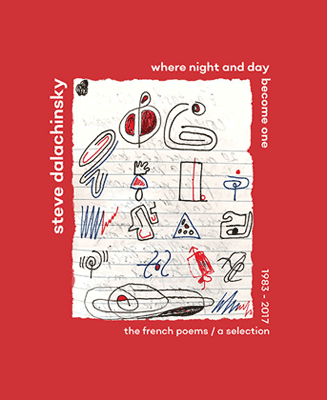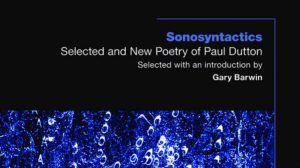Where Night and Day Become One: The French Poems / A Selection 1983-2017 by Steve Dalachinsky / great weather for MEDIA / 978-0998144030 / 2018
 The American artist’s fascination with France has been long lived and well covered. No matter how many American writers travel to Paris, readers still remain intrigued by the journey and the transformation that occurs while the exile is abroad. Steve Dalachinsky’s Where Night and Day Become One: The French Poems / A Selection 1983-2017 adds to the body of work in the American in France sub-genre of literature, but unlike many of his predecessors, Dalachinsky’s French poems give a greater insight into the mind of an American bound to what he was born, and what he was born and what he remains is a New Yorker. France is absorbed into Dalachinsky’s worldview, as Dalachinsky is assimilated into France and a French avant-garde aesthetic. Steve Dalachinsky, though often seeming to long for the departure that does not lead to return, never becomes the physically exiled. He remains the downtown Manhattan poet of the golden age now gone, who because of his ability to adapt, survives as an outsider embedded in an often hostile homeland. He brings his exile back home with him and masters it. Where Night and Day Become One shows the struggles of a writer who straddles more than one culture, becoming a hybrid in the fluidity of his poetry.
The American artist’s fascination with France has been long lived and well covered. No matter how many American writers travel to Paris, readers still remain intrigued by the journey and the transformation that occurs while the exile is abroad. Steve Dalachinsky’s Where Night and Day Become One: The French Poems / A Selection 1983-2017 adds to the body of work in the American in France sub-genre of literature, but unlike many of his predecessors, Dalachinsky’s French poems give a greater insight into the mind of an American bound to what he was born, and what he was born and what he remains is a New Yorker. France is absorbed into Dalachinsky’s worldview, as Dalachinsky is assimilated into France and a French avant-garde aesthetic. Steve Dalachinsky, though often seeming to long for the departure that does not lead to return, never becomes the physically exiled. He remains the downtown Manhattan poet of the golden age now gone, who because of his ability to adapt, survives as an outsider embedded in an often hostile homeland. He brings his exile back home with him and masters it. Where Night and Day Become One shows the struggles of a writer who straddles more than one culture, becoming a hybrid in the fluidity of his poetry.
Steve Dalachinsky, the American, traverses the Atlantic burdened by the heavy baggage of his Brooklyn past that now surfaces in a new light in France. He travels to Giverny for his father “who never heard of Monet/ who never stood in front of the water lilies/ & sighed” and it is also at Giverny that he picks up a stone from its garden to place upon his parents grave that he acknowledges that he will never visit. Monet’s Giverny is no longer Monet’s. Its profundity comes from what it evokes and what it evokes is a place far away and people long gone. “Giverny-trial & error # museum” is a long poem of regrets on the journey to and from a once paradise, now marketed to still be one. Dalachinsky is but one of many on the train ride to Giverny and he acknowledges this fact. In the end, he recognizes that he is there to see what he can take back with him. In “what we know” Dalachinsky wishes that his brother were still alive, so that he can tell him what he knows and receive a pat on the back. Dalachinsky’s point in his French poems is to take. What he gives back is the poetry itself.
France is a backdrop to workout long held psychological obsessions and to arrive at the truth from a different angle. The poem “collectivism” begins in the Marais section of Paris.
i am in a middle eastern
restaurant on the rue rosier
while all of the “good” jews are on the
5th floor praying
In the heart of the old Jewish ghetto of Paris, the Brooklyn Jew who wonders where his place is, is left to stand up, exit and wander up the Boulevard Richard Lenoir and beyond. Dalachinsky is not an exile that will find a home where he can finally rest his head, for he is, in his very essence exiled.
In “Trust Fund Babies” Dalachinsky writes about
members of my own lost tribe
wandering the terminals
not so much lost anymore but in search of…..
He leaves the thought open and embraces the fact that he is one of the lost searchers. His tribe is the outsider artist, people such as Richard Wright who is “stuck in the/ corner/ by/ the staircase” in Père Lachaise Cenetery and for whom he leaves a flower behind at the square in the wall where the Native Son author’s ashes are interred. There is also Artaud who spent his last four years in madness at Ivry-sur-Seine where Dalachinsky who “within the space of nowhere” sees a cherry tree and after contemplating Artaud’s insanity puts down a “chant of liberté d’esprit un poem authentique un grand partage incomparable”. He is one amongst these many outsiders and the outsider above all to be looked at in comparison to Dalachinsky is his friend Ted Joans.
Joans is the quintessential exile; a man who carried “secrets in his water sack, / & his passport around his neck,” who knew “Bird, Breton & Kerouac” and, in the end also Dalachinsky. Ted Joans is the embodiment of freedom. It is not only freedom in the physical sense, but in the conceptual made manifest. This concept is something so rarely lived, even by the most noble hearted. Joans is Dalachinsky’s beacon, luminous in spirit, an individual not roped to a reality that is destructive to the soul. Dalachinsky remembers his friend in “Le Corbeau et le Courbet- for Ted Joans” as he sits in Le Roquet where he and Joans sat in days past. He asks the waiter if he remembers his friend and gets as a reply “yes, he’s been dead 2 yrs” leaving Dalachinsky to reply simply “he was mon gran ami.” He is left to watch the waiter clean the table as he remembers his past in Paris.
It is through Joans’s motto “jazz is my religion, and surrealism is my point of view” that a greater insight into Steve Dalachinsky’s poetry can be achieved. Dalachinsky’s rhythms of free formed riffs formulated into an ever building ecstatic musicality come out of his incredible depth of understanding of jazz. Though sometime looked upon as a descendant of the Beat Movement he is far more complex.
Dalachinsky is the poet of Free Jazz. Within the white Beat Generation, for the most part, the writers were jazz dilettantes who never expanded substantially beyond their love of Bebop and Bird. If there is anything that truly connects Dalachinsky’s work with the Beats it is his rhythmic understanding and control of the phonetic groove of language in relationship to the musical beat which was much more a part of the work of the African-American Beats such as Amiri Baraka, Bob Kaufman and, of course, Ted Joans. As Dalachinsky states in “trial & error # camera & ballet”
i am more a hearing person
than a seeing person
tho the colors do reach me in time
What colors the poems in where night and day become one is the knowledge of the style and technique of the French avant-garde. Though Dalachinsky states in “Trust Fund Babies'” “if only i could discipline myself learn teachnique…” he is very well aware of the techniques of surrealism. His breath of knowledge, and ability to control it to achieve his own ends, is comparable to John Ashbery’s prowess at transmuting the mode of the continental European vanguard of literature into an American vernacular. Dalachinsky is at ease in the mind and artistic forms of the likes of such diverse geniuses as Apollinaire and Satie and he is able to use this knowledge for the building of his particular technique. Dalachinsky’s surrealism is put upon the page as one of many points of view that become particularly his own.
where night and day become one, the french poems/ a selection 1983-2017 is a masterful look at how the foreign environment enriches the exile’s mind and illuminates the native returned. Steve Dalachinsky’s Americanisms, free jazz linguistic resonance, New York lyricism and the weight and wealth of his Jewish heritage are all brought into a higher focus after his time spent in France. As Dalachinsky states at the end of “digressions 1 & 2”
hey – I am the first man. i told you that the trip would be a short one. i’ll get over it.
everybody’s bubble bursts eventually. just didn’t expect it to happen so soon.
ah but even w/its short life. short temper. its longwinded shortness of breath.
looking out the window @ the young man’s face i suddenly for the first time
reply:
i’d rather be american (or wood eye?)





Leave a Reply